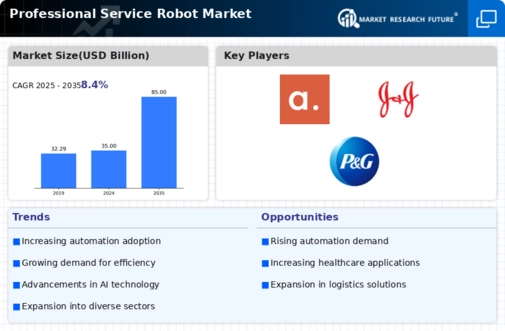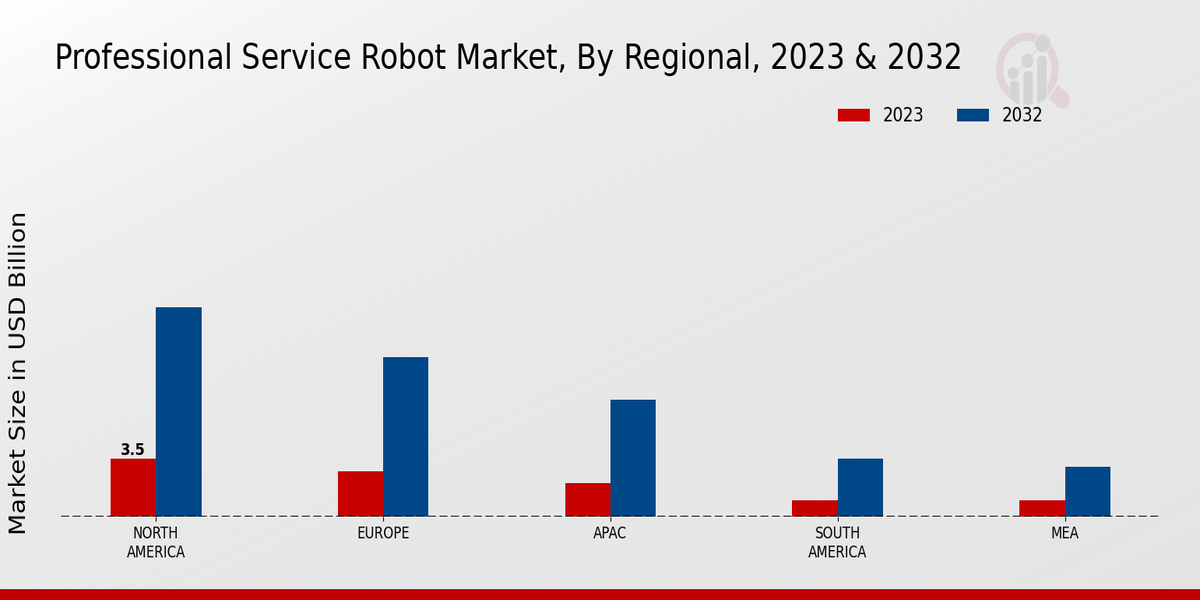Aging Population
The Global Professional Service Robot Market Industry is significantly influenced by the aging population worldwide. As the demographic shifts towards an older population, there is an increasing need for assistance in healthcare and daily living activities. Service robots are being developed to cater to this demographic, providing support in areas such as mobility assistance and medication management. Countries with rapidly aging populations, such as Japan and many European nations, are leading the way in adopting these technologies. This growing need for elderly care solutions is likely to drive market expansion, aligning with the broader trends of healthcare automation and service robot integration.
Rising Labor Costs
The Global Professional Service Robot Market Industry is also propelled by rising labor costs across various regions. As wages increase, businesses are seeking cost-effective solutions to maintain profitability. Service robots present a viable alternative, capable of performing repetitive and mundane tasks with precision and efficiency. For instance, in retail environments, robots are being utilized for inventory management and customer service, thereby reducing the reliance on human labor. This shift not only helps in managing operational costs but also enhances service quality. The ongoing trend of labor cost escalation is expected to further stimulate the adoption of service robots in the coming years.
Market Growth Projections
The Global Professional Service Robot Market Industry is projected to experience substantial growth over the next decade. With a market value expected to reach 35 USD Billion in 2024 and 85 USD Billion by 2035, the industry is poised for a transformative phase. The anticipated compound annual growth rate of 8.4% from 2025 to 2035 indicates a robust expansion trajectory. This growth is driven by various factors, including technological advancements, increased demand for automation, and the need for efficient solutions across sectors. The evolving landscape of service robots suggests a promising future for the industry, with numerous opportunities for innovation and application.
Technological Advancements
The Global Professional Service Robot Market Industry is experiencing rapid growth driven by continuous technological advancements. Innovations in artificial intelligence, machine learning, and robotics are enhancing the capabilities of service robots, making them more efficient and versatile. For instance, robots equipped with advanced sensors and navigation systems are increasingly utilized in healthcare settings for tasks such as patient monitoring and assistance. As these technologies evolve, they are expected to contribute significantly to the market, which is projected to reach 35 USD Billion in 2024. This growth reflects the increasing demand for automation across various sectors, indicating a robust trajectory for the industry.
Increased Demand for Automation
The Global Professional Service Robot Market Industry is witnessing a surge in demand for automation across multiple sectors. Businesses are increasingly adopting service robots to enhance operational efficiency and reduce labor costs. For example, in the hospitality sector, robots are being deployed for tasks such as room service and cleaning, allowing human staff to focus on more complex duties. This trend is expected to propel the market, with projections indicating a growth to 85 USD Billion by 2035. The anticipated compound annual growth rate of 8.4% from 2025 to 2035 underscores the potential for service robots to transform traditional business operations.
Global Health and Safety Standards
The Global Professional Service Robot Market Industry is increasingly shaped by stringent health and safety standards. As industries strive to comply with regulations, the integration of service robots is becoming a strategic approach to enhance safety and efficiency. For example, in the food service industry, robots are employed for food preparation and delivery, minimizing human contact and ensuring hygiene. This trend is particularly relevant in sectors where safety is paramount, such as healthcare and food services. The emphasis on health and safety is likely to drive the adoption of service robots, contributing to the overall growth of the market.













